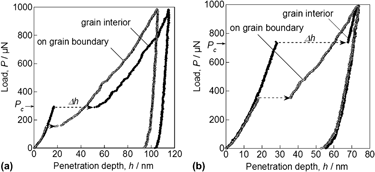Crossref Citations
This article has been cited by the following publications. This list is generated based on data provided by
Crossref.
Dub, S. N.
Loboda, P. I.
Bogomol, Yu. I.
Tolmacheva, G. N.
and
Tkach, V. N.
2013.
Mechanical properties of HfB2 whiskers.
Journal of Superhard Materials,
Vol. 35,
Issue. 4,
p.
234.
Catoor, D.
Gao, Y.F.
Geng, J.
Prasad, M.J.N.V.
Herbert, E.G.
Kumar, K.S.
Pharr, G.M.
and
George, E.P.
2013.
Incipient plasticity and deformation mechanisms in single-crystal Mg during spherical nanoindentation.
Acta Materialia,
Vol. 61,
Issue. 8,
p.
2953.
OHMURA, Takahito
2013.
Prospects of Nanoindentation and Related Techniques.
Journal of the Japan Society for Precision Engineering,
Vol. 79,
Issue. 12,
p.
1181.
Lysenko, O. G.
Dub, S. N.
Grushko, V. I.
Mitskevich, E. I.
and
Tolmacheva, G. N.
2013.
Study of phase transformations in silicon by scanning tunneling spectroscopy and nanoindentation.
Journal of Superhard Materials,
Vol. 35,
Issue. 6,
p.
350.
OHMURA, Takahito
2013.
Evaluation of Mechanical Properties by Nano-scale Characterization.
Journal of the Japan Society for Technology of Plasticity,
Vol. 54,
Issue. 633,
p.
886.
Ohmura, Takahito
2014.
Local Mechanical Behavior Related to Materials Properties<br/>^|^mdash;A Grand Challenge through Nano-Mechanical Characterization^|^mdash;.
Materia Japan,
Vol. 53,
Issue. 7,
p.
312.
Marukawa, Kenzaburo
and
Ohmura, Takahito
2014.
Dislocation Theories Applied to the Elucidation of Mechanisms of Metal Strengthening.
Tetsu-to-Hagane,
Vol. 100,
Issue. 9,
p.
1076.
Seok, Moo-Young
Choi, In-Chul
Moon, Joonoh
Kim, Sungju
Ramamurty, Upadrasta
and
Jang, Jae-il
2014.
Estimation of the Hall–Petch strengthening coefficient of steels through nanoindentation.
Scripta Materialia,
Vol. 87,
Issue. ,
p.
49.
Tarumi, Ryuichi
and
Shibutani, Yoji
2015.
Mechanical Stability Analysis on Ideal Body-Centered Cubic Crystals under Finite Deformation.
Tetsu-to-Hagane,
Vol. 101,
Issue. 8,
p.
435.
Dingreville, Rémi
Karnesky, Richard A.
Puel, Guillaume
and
Schmitt, Jean-Hubert
2016.
Review of the synergies between computational modeling and experimental characterization of materials across length scales.
Journal of Materials Science,
Vol. 51,
Issue. 3,
p.
1178.
Hsieh, Yi-Chieh
Zhang, Ling
Chung, Tsai-Fu
Tsai, Yu-Ting
Yang, Jer-Ren
Ohmura, Takahito
and
Suzuki, Takuya
2016.
In-situ transmission electron microscopy investigation of the deformation behavior of spinodal nanostructured δ-ferrite in a duplex stainless steel.
Scripta Materialia,
Vol. 125,
Issue. ,
p.
44.
Sekido, N.
Ohmura, T.
and
Tsuzaki, K.
2017.
Application of Radio Frequency Glow Discharge Sputtering for Nanoindentation Sample Preparation.
Journal of Materials Engineering and Performance,
Vol. 26,
Issue. 3,
p.
1245.
Sekido, Nobuaki
Ohmura, Takahito
and
Perepezko, John H.
2017.
Mechanical properties and dislocation character of YB4 and YB6.
Intermetallics,
Vol. 89,
Issue. ,
p.
86.
Wada, Yusuke
Sekido, Nobuaki
Ohmura, Takahito
and
Yoshimi, Kyosuke
2018.
Effect of Indentation Orientation on the Onset of Plastic Deformation for a MAX Phase Ti<sub>2</sub>AlC.
Journal of the Japan Institute of Metals and Materials,
Vol. 82,
Issue. 5,
p.
162.
Esfahani, Mahsa
Munir, Khurram S.
Wen, Cuie
Zhang, Jie
Durandet, Yvonne
Wang, James
and
Wong, Yat Choy
2018.
Mechanical properties of electrodeposited nanocrystalline and ultrafine-grained Zn-Sn coatings.
Surface and Coatings Technology,
Vol. 333,
Issue. ,
p.
71.
Araki, S.
Mashima, K.
Masumura, T.
Tsuchiyama, T.
Takaki, S.
and
Ohmura, T.
2019.
Effect of grain boundary segregation of carbon on critical grain boundary strength of ferritic steel.
Scripta Materialia,
Vol. 169,
Issue. ,
p.
38.
Nakano, Katsuya
and
Ohmura, Takahito
2020.
Effect of Solute Carbon on Onset of Local Plastic Deformation in BCC Iron.
Tetsu-to-Hagane,
Vol. 106,
Issue. 6,
p.
372.
Yashiro, Naoki
Oohira, Kouya
Sugimura, Natsuko
and
Washizu, Hitoshi
2021.
Improvement of Discrete Element Simulation Accuracy of Steel Powder Filling Behavior by Optimization of Contact and Friction Parameters.
Tribology Online,
Vol. 16,
Issue. 1,
p.
16.
Nakano, Katsuya
Takeda, Kengo
Ii, Seiichiro
and
Ohmura, Takahito
2021.
Evaluation of Grain Boundary Strength through Nanoindentation Technique.
Journal of the Japan Institute of Metals and Materials,
Vol. 85,
Issue. 1,
p.
40.
Li, Hongxing
Gao, Si
Tomota, Yo
Ii, Seiichiro
Tsuji, Nobuhiro
and
Ohmura, Takahito
2021.
Mechanical response of dislocation interaction with grain boundary in ultrafine-grained interstitial-free steel.
Acta Materialia,
Vol. 206,
Issue. ,
p.
116621.



